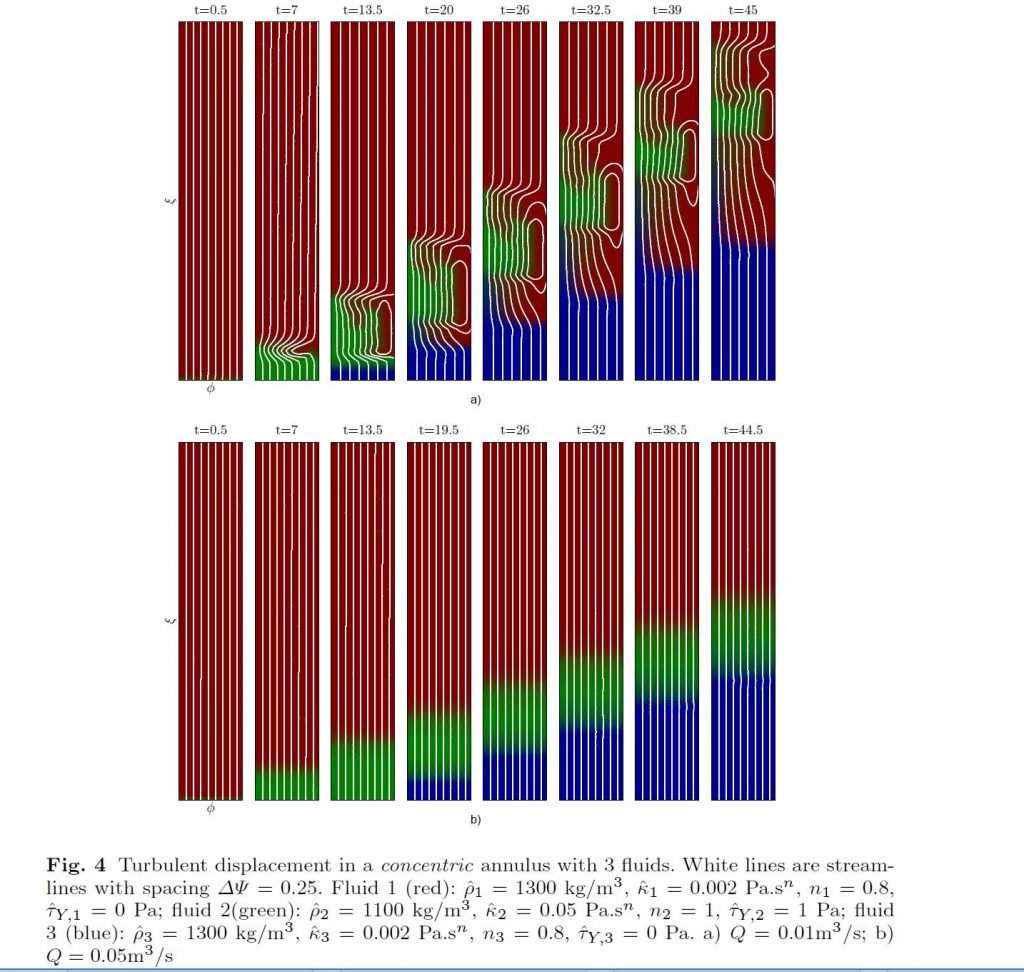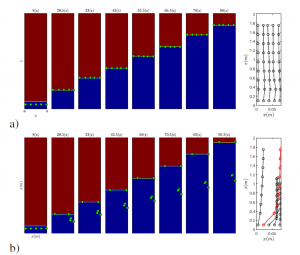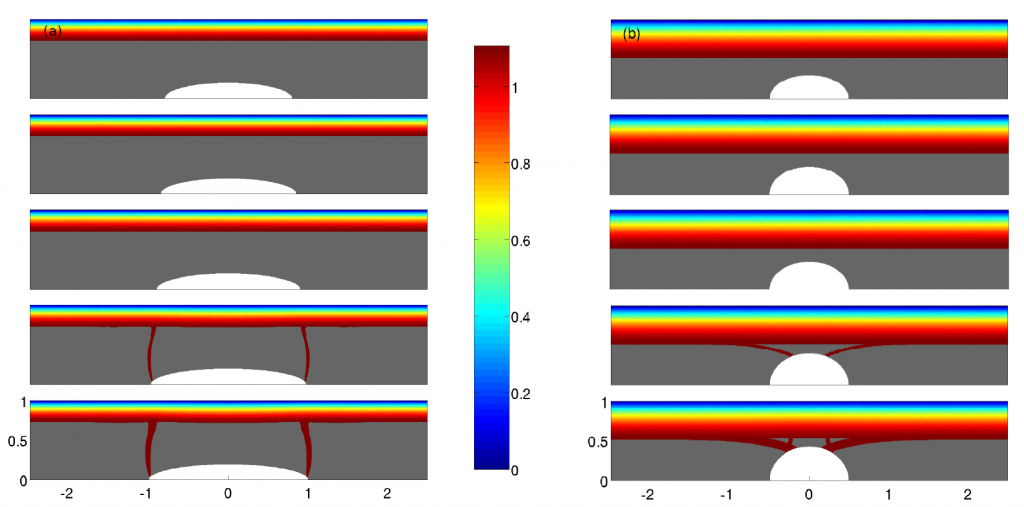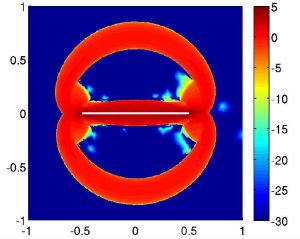My scientific motivation is to understand physical problems using different mathematical tools. My main field of interest is non-Newtonian fluid mechanics, and more specifically viscoplastic fluids. Viscoplastic fluids do not flow unless they are sufficiently stressed. Toothpaste, chocolate and cement slurries are the most common viscoplastic fluids.
Here is a list of projects I have been working on during my graduate studies:
Primary cementing of oil and gas wells: annular turbulent displacement of viscoplastic fluids
Large numbers of oil & gas wells (in Canada and worldwide) allow leakage to the surface of reservoir fluids. Failure of primary cementing is the number one reason for this leakage. The aim of this study is to understand why a cement job may fail and to propose means by which it can be avoided. In particular, we want to understand how the displacement of viscoplastic fluids works in turbulent flow regime.
This study resulted in several controversial conclusion: 1) In contrary to what is believed in the industry, turbulent displacement is not necessarily better than laminar displacement. It is only in vertical or nearly vertical wells that mildly turbulent displacement can be more efficient. We discuss this in detail in Maleki17. 2) Light-weight preflushes (wash) are normally low viscous light-weight fluids that are pumped before the leading slurry. It is believed that the wash provides a barrier between slurry and mud and helps to clean the well. In MalekiOMAE18, we show that this idea is generally flawed.

Primary cementing of foamed cements
Foamed cement slurries have a number of claimed advantages, such as lower density and higher resiliency. Their density and rheology is however pressure dependent which therefore make the cementing process more complicated. The disastrous Deepwater Horizon oil spill in the Gulf of Mexico has left major concerns in using foamed cements. Major theme of the investigations show themes of the investigation of the incident concerned the stability of the foamed slurry, its testing and suitability for this well.
In Hanachi18, we derive a 2D model for annular displacement of weakly compressible yield stress fluids. We show that in the absence of careful control, buoyancy driven instabilities can appear in the annulus which leave the displacement unstable, and therefore unsuccessful.
A novel technique to track the fluid interface in primary cementing
We proposed a novel technique to to track the interface between two fluids during primary cementing. The main idea is to exploit the density difference between successive fluids pumped in order to design a tracer particle to sit at the interface. Although apparently trivial, such particles must also overcome strong secondary flows in order to remain in the interface. We provide a proof of concept analysis of this situation in a narrow vertical annulus and demonstrate its feasibility. This work is under development in collaboration with Sintef Petroleum AS. The preliminary results can be found in FLUCCSOMAE18.

Dispersion of weakly turbulent flows of viscoplastic fluids
Dispersion is a mode of mixing due to the transverse profile of velocity. Dispersion in pipe flows was initially studied by G.I. Taylor (Taylor1,Taylor2). We extend Taylor’s framework to shear-thinning yield stress fluids. We focus on dispersion in turbulent regimes, especially weakly turbulent flows. The main purpose of this study is to consider the effect of dispersion in primary cementing of oil and gas wells. We observed that in weakly turbulent flows, the universal log-law profile of velocity introduces enormous errors in estimating the value of dispersion coefficient. That’s being said, a proper modeling of wall layer is crucially needed. More detail of this study can be found in Maleki16.

Macro-size drop encapsulation
Viscoplastic fluids do not flow unless they are sufficiently stressed. We exploit this unique feature to encapsulate droplets, for the purpose of transportation. For example, this method enables us to conduct “acid fracturing” without compromising the wellbore walls by contact. The main advantage of this method compared to the others that involve capillary forces is that significantly larger droplets may be stably encapsulate governed by the length scale of the flow and yield stress of the encapsulating fluid. This study is published in the Journal of Fluid Mechanics (Maleki15). A more detailed version of this study can be found here (MSc Thesis). Figure below shows cases where a droplet is (un)successfully encapsulated in a viscoplastic fluid. The gray area are the moving plug region. The droplet rigidly moves with the plug region. When the droplet is too large (=too fat or too long), the plug is broken. At this point, the droplet will be prone to hydrodynamic instabilities.

Viscous boundary layers of viscoplastic fluids
In the limit of a relatively large yield stress, viscoplastic flows can develop narrow boundary layers. Oldroyd presented the first theoretical discussion of these viscoplastic boundary layers, offering an asymptotic reduction of the governing equations and a discussion of some model flow problems. In the current paper, we revisit Oldroyd’s viscoplastic boundary-layer analysis and his canonical examples of a jet-like intrusion and flow past a thin plate. More details can be found in Balmforth17.

Flow around a knife cutting through a viscoplastic fluid. (Contour of strain rate second invariant. Blue region are unyielded, red regions are yielded)
Mixing jets of viscoplastic fluids
Mixing of viscoplastic fluids is a ubiquitous process in many industries. For example, in anaerobic digestion, the municipal sludge need to be continuously mixed in order to increase the yield of biogas. One method of mixing is the so called “submerged jet mixing”. We study this method using augmented Lagrangian method for inertial laminar mixing flows. see Maleki18.

Inverse bamboo instabilities

The experiment of Gabard and Hulin. Fluid 1 and 2 are water and xanthan. The flow configuration becomes unstable. The arrow shows the flow direction. Courtesy of Gabard and Hulin.
Gabard and Hulin ran a series of multi-layer flows experiments with water and xanthan. They observed that the interface between the two fluids is initially stable, but after relatively long time it becomes unstable. The shape of instability reminds what Joseph and co-workers called Bamboo waves.
Size variation of liquid drops during free fall

This is a work I did during my undergraduate research. I developed the image processing code + was involving in conducting the experiment. Perhaps the most interesting result of this study was to see how the droplet shape oscillates as it falls. The period of these oscillations is purely a function of Ohnesorge number. See Aminzadeh12 for more details.
